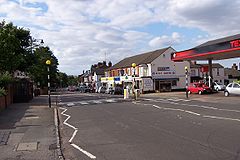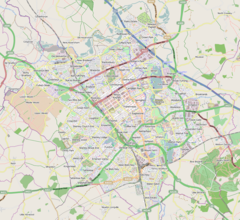Woburn Sands
| Woburn Sands | |
|---|---|
 Woburn Sands High Street | |
 Woburn Sands Mapping © OpenStreetMap##Location within | |
| Population | 2,916 (2011 Census)[1] |
| OS grid reference | SP927360 |
| Civil parish |
|
| Unitary authority | |
| Ceremonial county | |
| Region | |
| Country | England |
| Sovereign state | United Kingdom |
| Post town | Milton Keynes |
| Postcode district | MK17 |
| Dialling code | 01908 |
| Website | Woburn Sands Town Council |
Woburn Sands (/ˈwoʊbərn/) is a town that straddles the border between Buckinghamshire and Bedfordshire in England, and also is part of the Milton Keynes urban area.[2] The larger part of the town is in Woburn Sands civil parish, which is in the Borough of Milton Keynes,[3] Smaller parts of the town are in the neighbouring parishes of Aspley Guise and Aspley Heath (in Central Bedfordshire).[1] The meandering boundary between Buckinghamshire and Bedfordshire means the Primary and Middle Schools that serve all of the town are both in Aspley Guise CP. Bedfordshire Police and Thames Valley Police both deal with law enforcement issues in the town. At the 2011 Census, the population of the civil parish (only) was 2,916,[1] that of the built-up area (including much of Aspley Guise) was 5,959.[4] Woburn Sands, Aspley Guise and Aspley Heath each has its own centre but together the three settlements are a contiguous built-up area.[1]
History[]
The earliest evidence of settlement is an Iron Age hill fort dating from around 500 BC, called Danesborough Camp which is located to the southwest of the present town.[5] Later when the settlement had developed into a hamlet, it was part of the parish of Wavendon, becoming a separate civil parish in 1907. Under the Local Government Act 1972 the parish council has adopted the status of a town in its own right. It has separated from Wavendon parish which is just to the north of the Marston Vale line.
The village name was originally Hogsty End, one of Wavendon's four 'ends' (along with Church End, Cross End and Lower End) but by Victorian times, this un-picturesque name had fallen out of favour, and Woburn Sands had taken over as the accepted name. The modern name is credited to a schoolmaster unable to attract business to his "Hogsty End Academy", and was one of the first to promote the use of the new name.[6] The modern place name is related to nearby Woburn in Bedfordshire, and to the sandy local soil resulting from its proximity to the Greensand Ridge, an escarpment of Greensand that is part of the Woburn Sands Formation.
Transport[]
The town is served by Woburn Sands railway station which co-serves the south end of Wavendon. The station is on the Marston Vale line, three closely placed stops east of Bletchley railway station, a junction station with the West Coast Main Line.
The town is situated roughly midway between Woburn and Junction 13 of the M1 motorway, about 2 mi (3 km) north-east of the town.
References[]
- ^ Jump up to: a b c d UK Census (2011). "Local Area Report – Woburn Sands civil parish (E04012196)". Nomis. Office for National Statistics. Retrieved 26 April 2019.
- ^ UK Census (2011). "Local Area Report – Milton Keynes Built-up area (E34005056)". Nomis. Office for National Statistics. Retrieved 29 March 2019. See map.
- ^ "Parishes in Milton Keynes". Milton Keynes Council. Archived from the original on 8 June 2009.
- ^ UK Census (2011). "Local Area Report – Woburn Sands Built-up area sub division (E35000347)". Nomis. Office for National Statistics. Retrieved 1 October 2019.
- ^ "Danesborough Hill Fort, Aspley Heath". Milton Keynes Heritage Association. Retrieved 26 April 2019.
- ^ "How 'Hogsty End' became 'Woburn Sands'". Milton Keynes Heritage Association. Retrieved 26 April 2019.
External links[]
- Civil parishes in Milton Keynes Borough
- Hill forts in Buckinghamshire
- Areas of Milton Keynes
- Towns in Buckinghamshire
